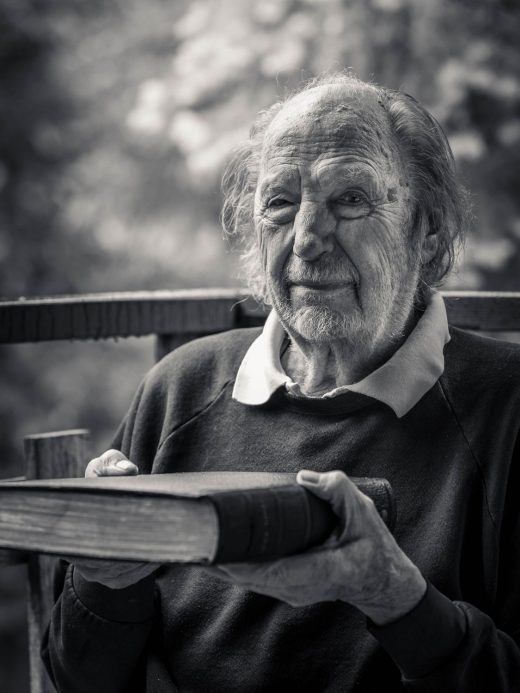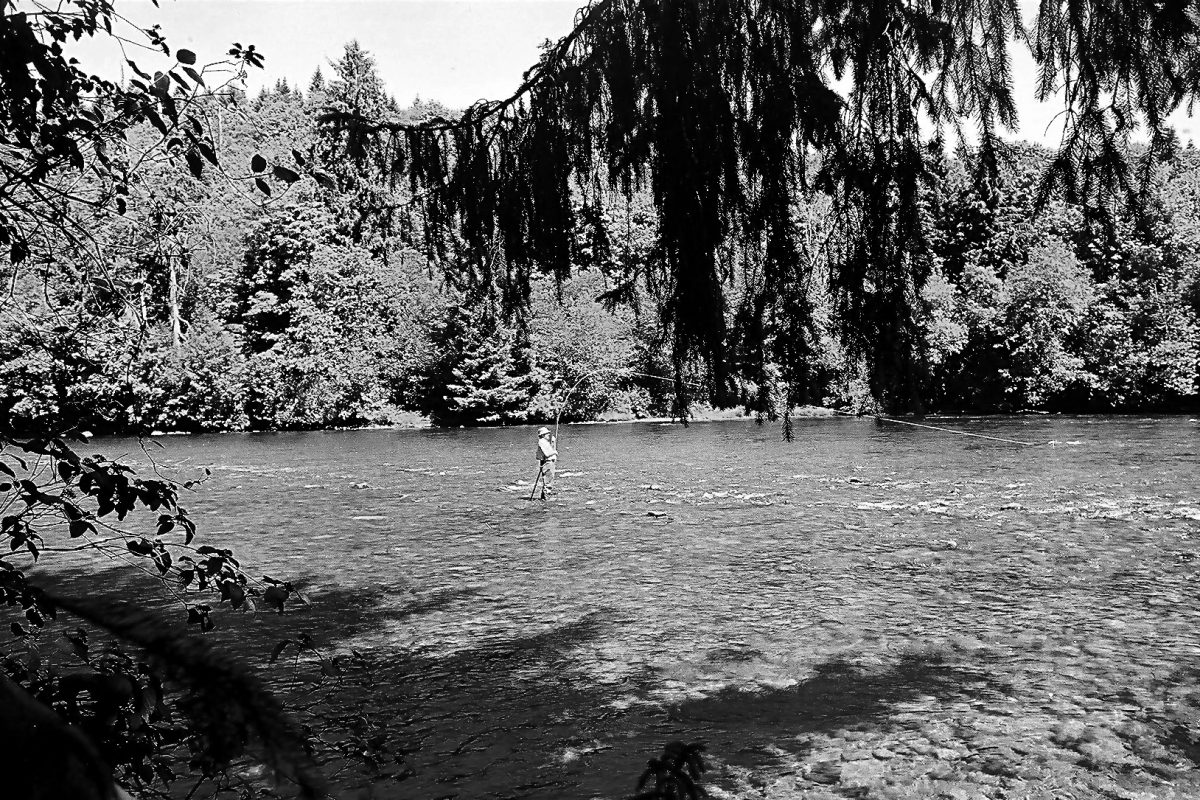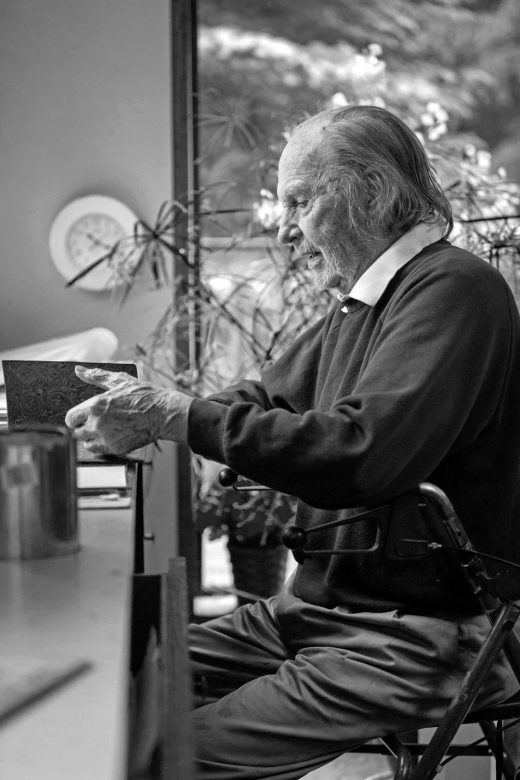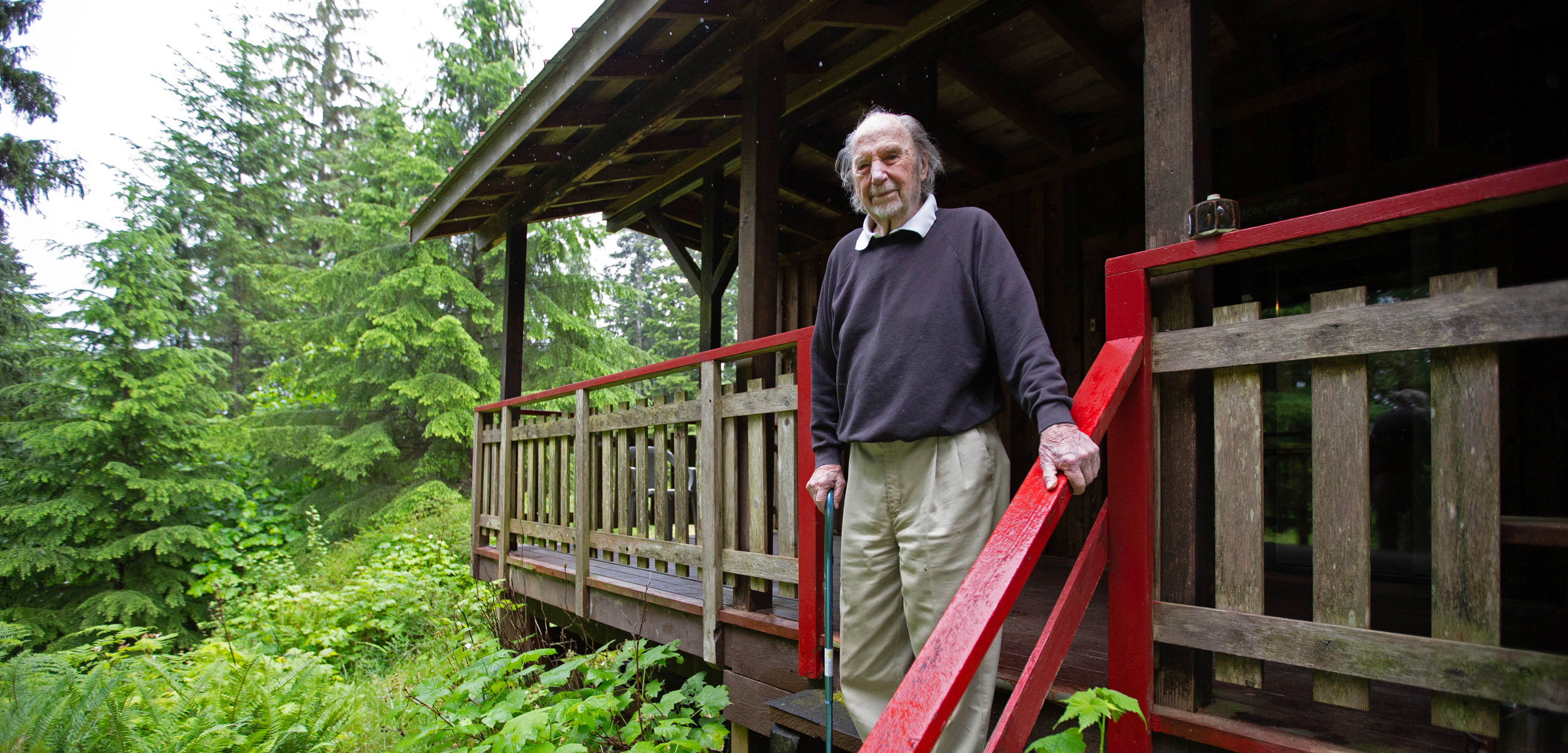The Oracle of Oyster River
On Vancouver Island, a hermit-priest has spent a lifetime contemplating the natural world. At 95, he has come to believe there is a way we can save it.
Article body copy
Congratulations to Brian Payton on winning a Digital Publishing Award for this article.
It is early morning with its quiet coolness. I walk out the old logging road. … The logging road along with other trails through the forest is where I practice walking meditation. I do not think of the road as leading anywhere. It is the road to nowhere, the path on which I journey and have been journeying for a lifetime. Although it is the path to nowhere, in reality it is the way to everywhere, because it enables me to enter into communion with the whole community of beings.
—from Self and Environment by Charles Brandt
Slow down. Take a breath. Attend. Insight takes time. Charles Brandt has been meditating and praying on the east coast of British Columbia’s Vancouver Island since 1965. Over that time, he has come to some elegant conclusions about our place in the natural world. He gathered them slowly, through solitude, study, and quiet contemplation. He has acted upon them. Brandt is a Catholic hermit, priest, ornithologist, flight navigator, book conservator, and naturalist. The solitary path he has taken in life can be seen as both a radical departure from and a return to first principles.
Brandt’s hermitage lies at the end of an old logging road near the Oyster River. Surrounded by coastal temperate rainforest, it is a simple, two-story home made of shiplap cedar planks. It has plenty of windows, indoor plumbing, electricity, and internet access. It is a very long way from the Egyptian caves of the Desert Fathers, the first Christian hermits, who inspired him. Brandt built it himself and named it Merton House in honor of Thomas Merton, the author of The Seven Storey Mountain, the autobiographical account of a young man’s search for faith that is considered one of the most influential religious works of the 20th century.
Brandt is a calming presence, with eyes reflective of having reached both advanced age and wisdom. He seems perfectly present as he holds you in his gaze. He is tall and poised. He wears a loose-fitting sweater and old running shoes; not a clerical collar or habit. He appears not unlike other healthy people his age. And yet he is one in many millions—an ordained Roman Catholic hermit-priest. Although he relies on a walker, he does not hesitate to climb the stairs to his library where he keeps his copy of The Seven Storey Mountain as well as the other books on spirituality, philosophy, and ecology that have shaped him.
Back downstairs, he settles into a comfortable chair between his tidy desk and kitchen. Out every window is the view of understory and the trunks of towering trees.
“I was called to this life,” Brandt explains. “You don’t see anybody or hear anybody. [My hermitage] is on a beautiful salmon river. It’s just ideal for this kind of life.”
For over half a century, Brandt has walked the quiet road leading to his hermitage, his “road to nowhere.” As revelations of abuse and cover-ups eroded the moral authority of the Catholic Church around the world, he continued to meditate, pray, and observe the natural world around him. Over time, he came to consider himself not a theologian but an ecologian. Now, as he approaches the end of his journey, he is taking steps to ensure this land and hermitage are preserved in perpetuity. He also hopes the insights of his generation of ecological thinkers will live on beyond him.
Brandt was 13 when he fell under the spell of the man who famously went to live alone in the woods near Concord, Massachusetts—Henry David Thoreau, the renowned 19th-century American essayist, naturalist, abolitionist, and philosopher. Growing up on a farm near Kansas City, Missouri, Brandt was himself already a budding naturalist and avid birder in 1936 when he first got his hands on a copy of Thoreau’s masterwork, Walden. He was particularly taken with Thoreau’s attempt to develop awareness and empathy for the natural world, honing what Brandt calls the “latent senses.”
“He was my childhood hero,” Brandt says. “He went to the woods to find out what life was all about so that he would not have lived in vain.”

A bible bound by Brandt, a bookbinder by trade. The hermit has worked on near priceless tomes, including an original work by James Audubon. Photo by Grant Callegari
After high school, Brandt studied general science and biology at the University of Missouri, and soon realized that his true interest lay in natural history. The Second World War interrupted his post-secondary studies. Brandt enlisted in the US Air Force Reserve and trained as a navigator flying bombers. He did not declare himself a conscientious objector, but became deeply conflicted about his upcoming role in the war and sought the counsel of an Air Force chaplain. Then the atomic bombs were dropped on Japan and the war came to an end. Brandt never saw active duty overseas. After his discharge, he continued to seek spiritual guidance. He also followed his interest in the natural world to Cornell University, where he studied ornithology, took part in a birdsong recording project, and earned a bachelor of science degree.
Brandt’s budding spiritual quest led him to Nashotah House Theological Seminary in Wisconsin, as well as several Anglican religious communities. He was ordained an Anglican priest in England in 1952. Increasingly, he found himself drawn to Catholicism, the works of Thomas Merton, and the possibility of a contemplative life. So much so, he went to Kentucky to join the Abbey of Gethsemani where Merton was living as that monastic community’s first hermit. But Merton—who found the monastery too crowded, regimented, and noisy—urged Brandt to look elsewhere if he was serious about pursuing a solitary, contemplative life. Brandt took his advice and left. Ten years later, at the age of 42, after having spent eight years as a Trappist (Catholic) monk, Brandt arrived on Vancouver Island, where the local bishop had a reputation for being receptive to those who wished to pursue the hermit’s life.
What, exactly, is a hermit?
“I would define it as a monk who lives a solitary life spent in prayer,” Brandt says, “a life of simple meditation, [as he] earns his own living.”
The first hermits, the Desert Fathers, were monks who went to live in the desert around Alexandria, Egypt. In the third century CE, some 5,000 of them were taking part in what Brandt calls, “a big movement towards the hermit life,” when devout Christians followed Anthony the Great’s lead in trying to live out Jesus’s spiritual challenge: “If you wish to be perfect, go, sell your possessions, and give the money to the poor, and you will have treasure in heaven.” The Rule of St. Benedict, written around 530 CE, lists four types of monks, including those who live in a monastic community under an abbot, and those who live alone as hermits. In the Western church, hermits very nearly disappeared between the 16th and 19th centuries. But in the first half of the 20th century, interest was renewed—thanks in part to the writings of Merton—although those who sought to take up the hermit’s life found little acceptance in the Catholic Church at the time.
“I was the first hermit ordained to the priesthood in something like 200 years,” Brandt says. “It was really quite unusual.”

In 2008, Brandt was in his 80s and still fishing for steelhead on the Upper Islands Pool in the Campbell River, British Columbia. Photo by George Reid
In Greek, the word for hermit is eremite, which means “of the desert.” Catholic hermits by definition live solitary lives, but tend to live near one another in colonies to have some level of support. When Brandt arrived on Vancouver Island, there were eight men attempting to live as hermits on the banks of the Tsolum River—members of the Hermits of St. John the Baptist. They lived within walking distance of one another, and 23 kilometers from the town of Courtenay. But Brandt, like Merton, yearned for even more solitude. With the bishop’s permission, and the help of a donation from a Milwaukee brewery owner, he purchased 5.6 hectares of second growth forest on the Oyster River for CAN $9,000. In 1970, he moved his hermitage 12 kilometers north to this new location. Over the years, the other hermits on the Tsolum River drifted away—some got married, some left for other religious communities. Only Brandt remained on Vancouver Island, alone in the woods, praying, reading, living a hermit’s life.
In that life, Brandt found his thinking about the natural world and the spiritual life converging. He discovered his own thoughts reflected in the writings of Thomas Berry, a fellow Catholic priest, whose work—including the influential 1988 book The Dream of the Earth—helped inspire the philosophy of deep ecology, which regards human life as one of many equal components of a global ecosystem. Berry sought to broaden the focus of religion from individual salvation to care for the Earth. Brandt sums it up this way: the universe is a community of subjects to be communed with, not objects to be exploited. The Earth is a one-time endowment; we don’t get a second chance. The Earth is primary; humans and all other beings are derivative.
For those from a Judeo-Christian tradition, which decrees human dominion over “all the earth, and over every creeping thing that creepeth upon the earth” (Genesis 1:26), this philosophical and spiritual approach calls for nothing short of a Copernican revolution.
“Dear Mr. Pelton: The Tsolum River is dead!” So began an open letter by Brandt to British Columbia’s minister of the environment in 1985. According to Chris Hilliar, who was working for Canada’s Department of Fisheries and Oceans at the time, that letter turned the tide in what appeared to be a lost environmental cause. The Tsolum River, where Brandt began his life as a hermit, was poisoned by a nearby copper mine that operated between 1964 and 1966 and continued to leach toxic metals into the water, destroying a thriving salmon habitat. The knowledge that a “community of beings” living in the river was under attack led Brandt from contemplation and prayer to action. In 2016, on the 50th anniversary celebration of Brandt’s ordination, Hilliar paid tribute to his longtime friend for his tireless work to resurrect the Tsolum River.
“As a strategic environmentalist, Father Charles knew that to restore the Tsolum River we would have to force government to act,” Hilliar said. “And his ‘Tsolum River is dead’ letter did just that. It gave newspapers all the facts they needed. … Suddenly the Tsolum River was in the spotlight and government had their feet to the fire.”
Brandt was instrumental in establishing the Tsolum River Restoration Society and the campaign that resulted in the reclamation of the old copper mine (at a cost of $6-million), which led to the rapid return of salmon. Only eight pink salmon were counted in 1983; in 2016, the numbers had reached 130,000.
“Thirty years later,” Hilliar said in his address to honor Brandt, “the Tsolum River is on the road to recovery. Salmon runs are on the rise and people living in the watershed are active in stewardship programs and in restoration work. And it all started with a simple letter from a hermit-priest.”

The bell in Brandt’s hand was once used to call people to mass by Charles de Foucauld, a hermit in North Africa in the early 20th century who spent time among the Tuareg people and was later granted sainthood. Brandt has followed and revered the hermit’s teachings. Photo by Grant Callegari
In addition to Brandt’s efforts to restore the Tsolum, he went on to advocate for the protection of parks, forests, and the surrounding sea—work that has been honored with numerous awards.
“Immersed in the beauty of Earth,” Brandt says. “I had taken rather bold stands against several logging and mining companies that seemed bound to destroy all that I had come to the rainforest for.”
It was his life of contemplation and communion with the natural world that led to a deep love of it. It is that love, he says, that led him to act in its defense.
If ever a biography is written on the life of Charles Brandt, hermit-priest, it should be bound by hand. While the insight, wisdom, and spiritual sustenance found in books have undoubtedly enriched his life, it is the work of preserving and restoring books that has provided him a means to make his living.
In 1936, the same year he first read Walden, Brandt rebound his own Boy Scout manual, earning a bookbinding merit badge. Later, he worked as a bookbinder at St. Gregory’s Abbey in Shawnee, Oklahoma. When he arrived on Vancouver Island to begin his life as a hermit, Trappist monks in Oregon sent him enough equipment to start his own bindery.
Although his hermitage would remain his primary residence and place of work, he spent time away to study bookbinding and archival paper conservation in the United States and Europe. He worked for the Canadian Conservation Institute in Ottawa as well as in Manitoba. In all, he was away from his hermitage for 10 years, studying and working at his craft.
Can a hermit leave his hermitage and still be a hermit?

Brandt, 95, continues to breathe new life into old books in his bookbinding laboratory at his hermitage. Photo by Grant Callegari
“I was always coming back,” Brandt says, and he continued to live the hermit’s life—praying, meditating, living alone—even while away from the Oyster River. He notes that St. Paul was a hermit who made his living as a traveling tent builder. Instead of building tents, Brandt supported himself through bookbinding.
Over the years, Brandt helped conserve such priceless books as The Nuremberg Chronicle by Hartmann Schedel, printed in 1493. But the most important book—at least for this ornithologist, flight navigator, and naturalist—was a volume of John James Audubon’s masterpiece, Birds of America, published in 1838.
“I dismantled it, washed it, mended it, and made a box for it,” he says. “These were original, hand-watercolored Audubons.”
Only about 180 complete sets were ever produced and sold for about US $1,000 each. Brandt estimates that volume is now worth $12.5-million.
Brandt still occasionally works as a book and paper conservator, but his focus has now turned to the question: what happens after I’m gone?
The old logging road near the Oyster River was made to haul away timber when the land was logged back in 1931. Today, it is surrounded by rainforest towering up to 38 meters high. The hermit-priest still at work here is older than all of these trees. Recently, Brandt enlisted the help of the Comox Valley Land Trust to help him save this forest as a place where people can come to commune with the natural world. He has also established the Hermitage Advisory Committee to ensure that Merton House remains a refuge for another hermit, contemplatives from other religious traditions, writers, naturalists, or others in need of solitude for their work.
While it’s easy to see how declaring the land a sanctuary could benefit the natural world, and those who might visit it, what is perhaps less clear is the value to the wider world of having a contemplative there. Over 700 years ago, St. Thomas Aquinas said, “It is necessary for the perfection of human society that there should be men who devote their lives to contemplation.” Bruce Wood, current member of the Hermitage Advisory Committee, agrees. He says it’s still important for the rest of us to see contemplatives leading by example and, like Charles Brandt, turning contemplation into action.
“There are alternative ways besides just pursuing the material world,” Woods says. Contemplatives, such as Charles Brandt, “give us something to ponder.”
In his book, Self and Environment, Brandt writes, “This rainforest is not my property, but God’s creation. It manifests God’s hidden Being. … To realize our unity with all beings, and so to leave the world of duality is perhaps the most important step we take towards halting the environmental destruction that is taking place on the Earth.”
“We really have to fall in love with the natural world”—this is Brandt’s refrain. To save something you need to love it, to love something you need to consider it sacred, he says. “Your wife or your children or the natural world. Only the sense of the sacred will save us.”
By sacred Brandt means holy, “from the hands of God.” But for those who have difficulty with those religious concepts, sacred also means something that is held in the highest respect, something so precious it must never be taken for granted or squandered.
“I think everybody has some sort of love for the natural world,” Brandt explains. “They may not call it sacred, but somehow they relate to it. It motivates them and it moves them.”
At 95, Brandt continues to step out of his hermitage to open himself to the wonder of the natural world. Although he doesn’t travel as far down the old logging road as he once did, he still makes his way toward the same destination: communion.


